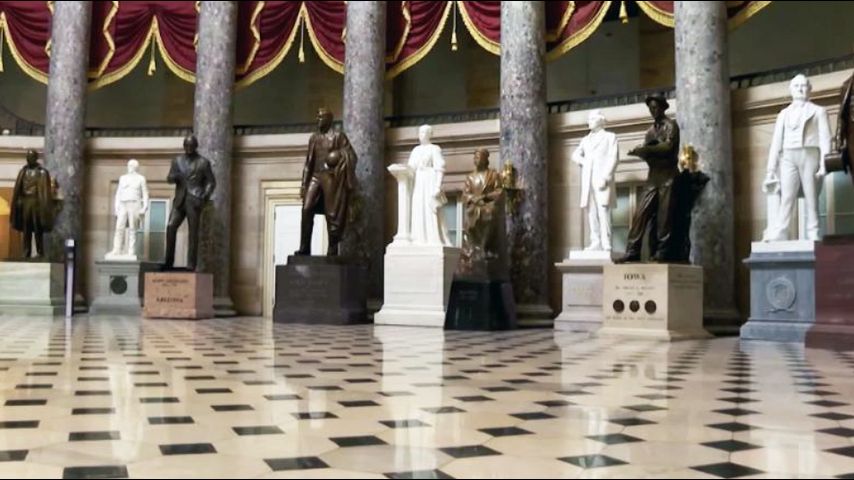US House Votes To Expel Confederate Sculptures
US House votes to expel confederate sculptures from the legislative hall in the midst of Hostile to Prejudice Fights.
The US House has affirmed a bill to expel sculptures of Gen. Robert E. Lee and other Confederate leaders from the U.S. Legislative hall, as retribution over racial foul play keeps following the police murdering of George Floyd, an Individual of color, in Minneapolis.
The House vote additionally would expel a bust of Boss Equity Roger B. Taney, the creator of the 1857 Dred Scott choice that announced African Americans couldn’t be residents.
The bill guides the Planner of the Legislative hall to recognize and in the end expel from Sculpture Corridor at any rate 10 sculptures respecting Confederate authorities, including Lee, the directing general of the Confederate Armed force, and Jefferson Davis, the Confederate president.
Three sculptures regarding racial oppressors — including previous U.S. VP John C. Calhoun of South Carolina — would be quickly evacuated.
“Safeguards and purveyors of rebellion, subjugation, isolation and racial oppression have no spot in this sanctuary of freedom,” House Lion’s share Chief Steny Hoyer said at a State house news meeting in front of the House vote.
The House affirmed the bill 305-113, sending it to the Republican-controlled Senate, where possibilities are dubious. Seventy-two Republicans, including House Minority Pioneer Kevin McCarthy of California and Minority Whip Steve Scalise of Louisiana, got together with 232 Democrats to help the bill.
Hoyer, a Democrat, co-supported the measure and noted with incongruity that Taney was conceived in the southern Maryland locale Hoyer speaks to. Hoyer said it was suitable that the bill would supplant Taney’s bust with another Maryland local, the late Incomparable Court Equity Thurgood Marshall, the high court’s first Dark equity.
The House vote comes as networks across the country rethink the individuals they’re memorializing with sculptures. Speaker Nancy Pelosi a month ago arranged that the pictures of four speakers who served the Alliance be expelled from the resplendent corridor simply outside the House chamber.
Rep. Barbara Lee, D-Calif., said the sculptures respecting Lee and other Confederate pioneers are “conscious endeavors to rework history and dehumanize African Americans.″
The sculptures “are not images of Southern legacy, as some case, yet are images of racial domination and resistance of government authority,” Lee said. “It’s previous time we end the glorification of men who submitted injustice against the US in a purposeful exertion to keep African Americans in chains.”
Bills to evacuate the Taney bust and the sculptures of Confederate pioneers have been presented in the Senate, despite the fact that they would require separate votes.
Regardless of whether the enactment passes the two chambers, it would require the president’s mark, and President Donald Trump has restricted the expulsion of memorable sculptures somewhere else.
Trump has firmly denounced the individuals who overturned sculptures during fights over racial shamefulness and police ruthlessness following Floyd’s demise in May and other police killings.
The 2-foot-high marble bust of Taney is outside a room in the Legislative center where the Incomparable Court met for 50 years, from 1810 to 1860. It was in that room that Taney, the country’s fifth boss equity, declared the Dred Scott choice, in some cases called the most noticeably awful choice in the court’s history.
“What Dred Scott said was, People of color didn’t make a difference,” Hoyer said. “So when we affirm that yes they do make a difference, it is out of conviction … that in America, the place where there is the free incorporates we all.”
There’s at any rate one conceivably amazing voice for Taney to remain. Lynne M. Jackson, Scott’s extraordinary incredible granddaughter, says on the off chance that it were up to her, she’d leave Taney’s bust where it is. Be that as it may, she said she’d include something as well: a bust of Dred Scott.
“I’m not so much a devotee of clearing things out,” Jackson said in a phone talk with this week from her home in Missouri.
The president and author of The Dred Scott Legacy Establishment, Jackson has seen other Taney models expelled as of late, especially in Maryland, where he was the state’s lawyer general before turning out to be U.S. lawyer general and afterward boss equity.
Calhoun, who filled in as VP from 1825-1832, additionally was a U.S. congressperson, House part, and secretary of state and war. He passed on 10 years before the Common War yet was known as a solid safeguard of subjugation, isolation and racial oppression.
His sculpture would be evacuated inside 30 days of the bill’s section, alongside two other racial oppressors, previous North Carolina Gov. Charles Aycock and James Clarke, a previous Arkansas representative, and congressperson.
In the mid year of 2017, not long after white patriots accumulated in Charlottesville, Virginia, to fight the expulsion of a sculpture of Lee, Baltimore’s city hall leader expelled sculptures of Lee, Taney, and others.
A sculpture of Taney was expelled from the grounds of the State House in Annapolis around a similar time. What’s more, a bust of Taney was expelled that year from outside city lobby in Frederick, Maryland.
Another Taney bust sits nearby all other previous boss judges in the Incomparable Court’s Extraordinary Lobby, a taking off, marble-sectioned passage that prompts the court. A picture of Taney hangs in one of the court’s meetings rooms.
Jackson said she accepts that what remembrances respecting figures like Taney need is setting. At the Legislative hall, the Taney sculpture sits in the “place where the Dred Scott case was chosen,” yet the reality he is “in this way himself is disproportionate,” Jackson said in recommending a bust of Scott is included. She had proposed a comparative fix for the Taney sculpture in Annapolis.
In Congress, Taney’s bust was disputable from the beginning. At the point when Illinois Sen. Lyman Trumbull proposed its creation in 1865, not long after Taney’s demise, he got into a warmed discussion with Massachusetts Sen. Charles Sumner, a wild rival of bondage.
“Let me tell that representative that the name of Taney is to be hooted down the page of history. Judgment is starting now,” Sumner said. “Also, a liberated nation will attach upon him the shame which he merits.”
Financing for a Taney bust wasn’t affirmed until just about 10 years after the fact. Today, close to the Taney bust, inside the old Incomparable Court chamber, there are likewise busts of the country’s initial four boss judges. The primary, John Marshall, is the main individual to fill in as boss equity longer than Taney and a respected figure in the law.




